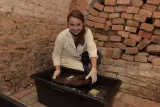Published: 24.01.2022
Experts from the Faculty of Restoration, the University of Pardubice, have just finished the restoration of a more than 7,000 years old well. The exceptionally preserved and significant prehistoric find, discovered in 2018 at Ostrov na Chrudimsku, has been conserved and prepared for handover. The unique Neolithic object will soon go to the East Bohemian Museum in Pardubice.
About a hundred fragile parts from two wells, one of oak wood and the other of fir, must be transported with the greatest care. "Even after preservation, the treated wood is not comparable in strength to ordinary wood. Yet, it can be transported if it's handled carefully. As we don't want to harm this unique world treasure during transport, we cover it with bubble wrap and place it in plastic transport containers," describes Ing. Karol Bayer, Vice-Dean for Research of the Faculty of Restoration, the University of Pardubice.
It took the restores over two years to save the four-sided oak well. "It's by far the oldest object that my colleagues and I've ever worked on at the faculty. Five restorers were involved in the rescue and conservation of the well, which required hundreds of hours of work," says Vice-Dean Karol Bayer.
An important part of saving the monument was to prepare an appropriate technological procedure. First, the restorers gently removed soil residues, treated the pieces of wood with a biocidal agent and impregnated them in a sucrose solution for 16 months. It was the sugar that was supposed to strengthen the wood and prevent it from shrinking or deforming during subsequent drying in a temperature- and humidity-controlled area. The wooden parts were left to dry on grates for another year while being closely observed by the scientists. "We closely watched if mould starts to appear on the surface and if the individual pieces don't shrink and deform. Finally, we monitored the weight fluctuations. Once it got stabilised, we concluded that the drying process was over," adds Karol Bayer.
The prehistoric well is 140 centimetres high and consists of four corner posts with grooves to hold planks that form the object's sides. The floor plan of the unique find is a square, with each side being 80 centimetres long. The archaeologists discovered the well in 2018 during a survey for the construction of the D35 motorway near Ostrov na Chrudimsku. In a very logistically and technically demanding operation, so far unprecedented in the Czech Republic, the well was retrieved from the site in a single block.
Subsequently, the experts from the Mendel University in Brno studied the growth rings to establish that the trees used to build the oak well had been felled between 5256 and 5255 BC, while the corner posts came from a trunk that had been cut down as early as the turn of 5259 and 5258 BC.
During the survey of the D35 motorway, the archaeologists uncovered another seven wells from different periods of prehistory.



